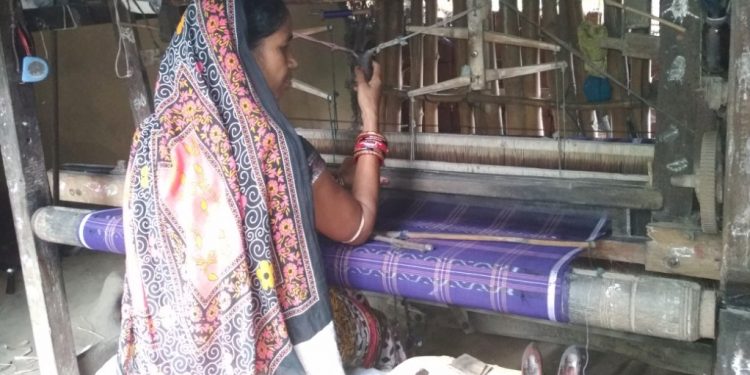Kendrapara: As many as 7,000 artisans have been rendered jobless following the closure of 70 per cent of the handloom units in Kendrapara district during the last three decades.
The handloom units had to close down following the arrival of modern machines and quality threads in the market. As a result, over 7,000 artisans earning their livelihood by weaving handloom clothes lost jobs to the modernisation wave sweeping the textile industry in the country.
The absence of government sponsorship, publicity and marketing facility is stated to be the reason behind the closure of these handloom units. Moreover, lack of modern weaving machines and quality threads dealt a body blow to the traditional handloom sector in this district.
The dhoti, napkin (gamchha) and clothes manufactured by these handloom units were once in great demand among the consumers in the state. However, with the passage of time, modern manufacturing machines and high-quality cotton thread forayed into the market and spelt disaster for these handloom units in the district.
Moreover, several handloom weavers’ cooperative societies which had been marketing their products have now become a thing of the past.
A weaver Kishore Dey of Thakurhat village said many looms have fallen silent as several weavers are now not keen on weaving sarees, lungis, dhotis, and towels. The increasing cost of raw materials has robbed the sheen off their businesses.
He said over 10,000 residents of Kushiapal, Dihasahi, Haripur, Korua, Kutaranga, Keutagada, and other villages were into weaving clothes. Handwoven napkins, dhotis, and shawls produced by these units were in great demand even in foreign countries, he added.
Weaving clothes in the loom was part of the school curriculum and a school was established for the purpose during the freedom movement launched by Mahatma Gandhi to overthrow British rule. Currently, there is great demand for handloom products in the country and abroad but many units are on the verge of closure while others have shut down due to absence of government sponsorship, Dey added.
Another weaver Narayan Bhadra of Korua village said handloom products are in great demand in and outside the state as well as in foreign countries. Weaving is the second source of livelihood for many after agriculture. Over 3,000 people are still engaged in weaving handloom clothes.
However, a fall in income has forced many youths to migrate to other states and abroad for a decent livelihood. Plagued by a series of problems and dwindling income, the youths have lost their faith in this business, he said.
Harekrushna Das, president of the Kushiapal handloom weavers’ cooperative society, said the demand for handloom products is still high among customers despite a sharp rise in the business of machine-woven clothes.
The handloom products are in great demand during marriages and various other festivals. However, lack of marketing facilities is troubling them, he said. Another weaver Ajay Kumar Behera said the increasing cost of raw materials and their shortage have hit the weavers hard.
Moreover, the government restrictions imposed on purchase of some chemicals have also hit the weavers hard as they have failed to prepare quality clothes and sarees. Things have come such a pass that weavers now fail to recover even the production cost of a handloom product due to a drop in profit margin.
This apart, handloom products do not get the kind of publicity that Sambalpuri handloom or Jhel saree of Mayurbhanj, usually worn by President Droupadi Murmu, he added.
When contacted, ADM Pitambar Samal said the state government is attaching utmost importance on the improvement of the handloom sector and marketing the products through the state government-owned Khadi Board and Boyanika.
Recently, the government has sanctioned Rs15 crore to Boyanika with which handloom products are purchased from the weavers. This will greatly help in improving the business of the weavers, he added.
PNN






































